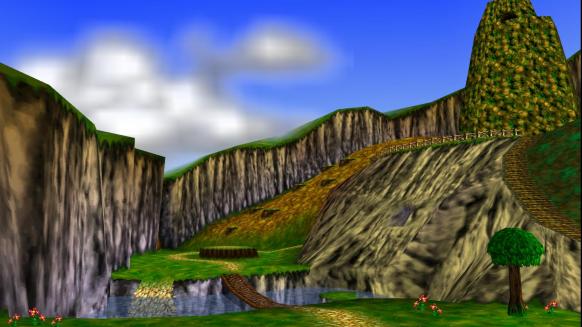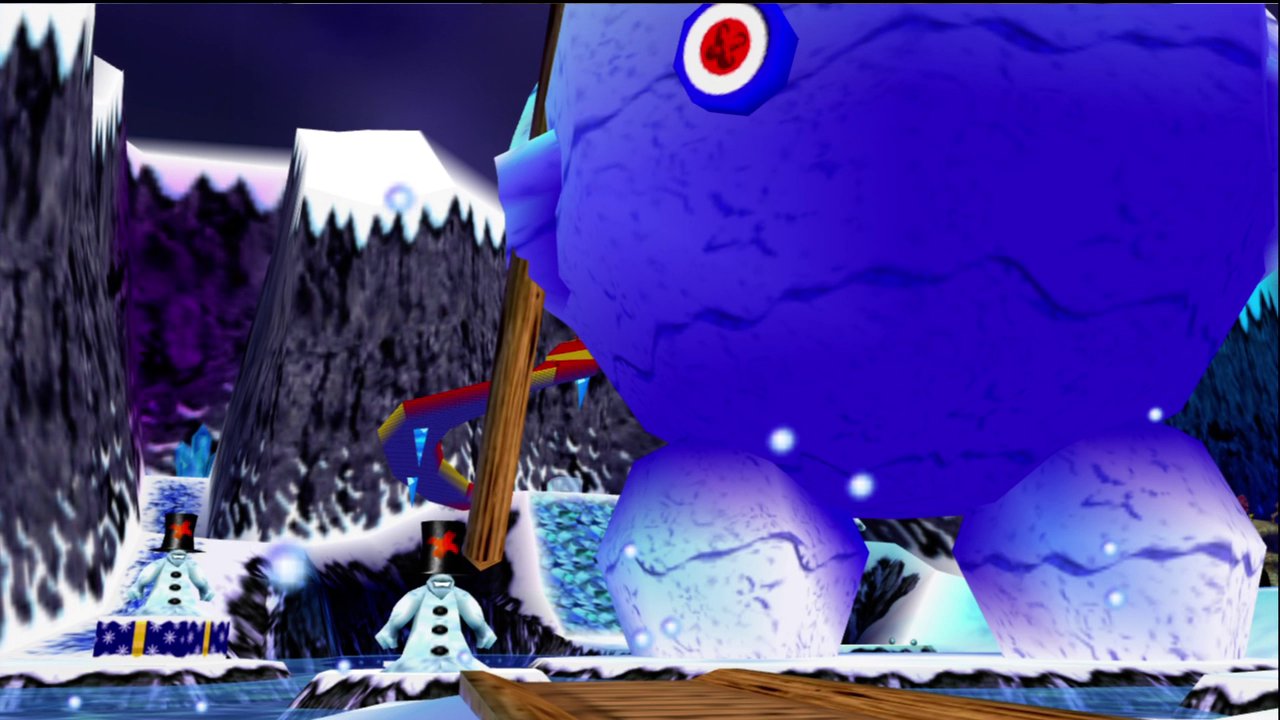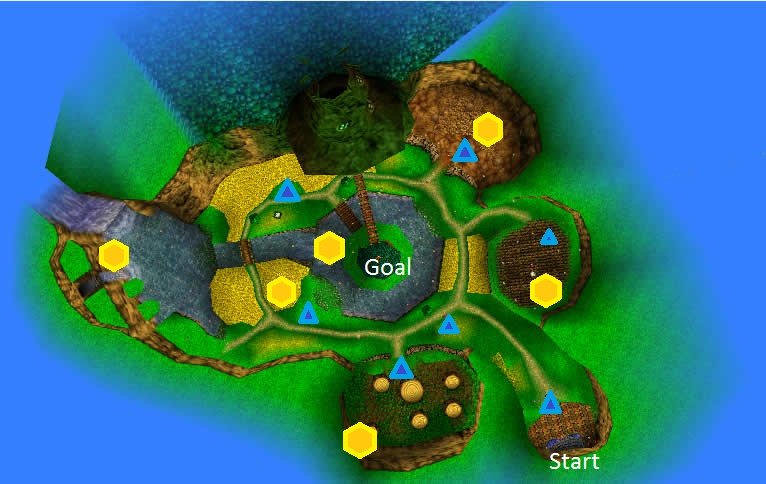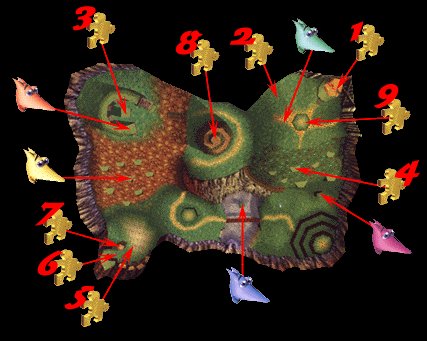In preparation for Yooka-Laylee, I wanted to talk about my favorite game. Banjo-Kazooie was an early 3D platformer created by Rare that has a very magical quality to it. It’s a game all about exploring open worlds and finding secrets. I want to explain some of the level design choices made that impact how players perceive the game. I won’t go through all the levels, but I want to focus the early ones in detail and then explain some general philosophies they had for the level design in general.
Spiral Mountain
The game starts in Spiral Mountain. The player starts with limited abilities. Banjo can only move and jump. The point of Spiral Mountain is to teach players the very basic abilities they will be using throughout the game.
Spiral mountain functions as a tutorial level, but in an open environment. Rather than forcing the players down linear corridors to teach them the game mechanics that games often do, the player is free to roam around and explore the world in whatever order they want. This freedom is important to the core principles of the game. They want to teach the player from the beginning to wander around and see what you can find. Secrets are hidden and it feels good finding them.
The world is structured so that players can go to different areas in the world, ask Bottles to teach you an ability, and optionally apply the basic ability to gain Honeycombs. The Honeycombs encourage you to touch them even though you don’t know what they do. They are golden floating objects that look so intriguing. When you collect them, they make a good sound to reward you and show you that you need to collect 6. This encourages players to collect all of them they see, which in turn helps them learn the abilities that will be used throughout the game.
It’s also an optional tutorial. You can tell Bottles to just teach them all the starting abilities from the beginning. This allows the player to not have to sit through all of his long speeches. If the player wants to go collect all the honeycombs in the world, they can. If not, they can just go straight up the mountain. For the players who tell Bottles they want him to teach the abilities one-by-one, they will be forced to go around and collect all the abilities before they proceed.
I think they should have allowed you to use all of the Spiral Mountain abilities from the start, but let you talk to bottles in the area you need to learn the abilities if you needed help with them. This would’ve been more natural open-worldness rather than ask you if you just wanted them all from the beginning and forcing you to go get them all if you said no. The level is even nicely designed to make you want to explore all of it before you move on. It would be hard for you to get to the top of Spiral Mountain without noticing at least 2 areas there should be honeycombs since it forces you to walk around the lake to cross a bridge.
They probably made the choice for a mandatory tutorial because it was one of the early 3D games, built for children especially, so they are trying to teach people how to move in 3D. Luckily, it’s pretty quick to get through Spiral Mountain anyway, so it’s okay.
Entering Gruntilda’s Lair
Once you get into Gruntila’s Lair, the real game begins. Gruntilda’s Lair feels spooky. It’s a great atmosphere shift from pleasant Spiral Mountain. Teaching you the Jiggy goes to the puzzle is natural. You have the ability to get the jiggy first if you stumble upon it before the puzzle, but if you miss it and go to the puzzle first, you can go back and find it pretty easily. This seems like a small detail but it’s a nice feature. This means skilled players can quickly grab the Jiggy first without having to backtrack later for it.
Teaching you that Jiggies go into to the puzzle feels natural. You have the ability to get the Jiggy first if you stumble upon it before the puzzle, but if you miss it and go to the puzzle first, you can go back and find it pretty easily. This seems like a small detail but it’s a nice feature. This means skilled players can quickly grab the Jiggy first without having to backtrack later for it.
A note on paintings: Seeing the paintings of the world let your imagination run wild and give you something to expect. You can’t wait to go there. Specifically, each piece you put in gives you just a little more to glimpse. In FFX, them talking about the itinerary does this same thing. It’s always nice to tell your players where they will be going and let them imagine being there. It makes it all the more rewarding when they finally reach the place.
Not being able to Talon Trot up the left path in the opening room to the lair is great. It makes the player want to go that way but can’t. Most will remember this when they find the Talon Trot in Mumbo’s Mountain. This consistently creeps up in the level design, showing us things we can’t reach or do yet in order to get us to keep playing more to figure out how to do it. Other examples include the Shock Jump Pad that leads to Clanker’s Cavern’s puzzle in the Treasure Trove Cove puzzle room, the Click Clock Wood puzzle that is completely empty and you can’t do anything with yet, and cauldrons that will act as warp points when you find the pair.
Mumbo’s Mountain
Mumbo’s mountain is jammed with content. Now that I know where everything is, I can get it in about 12 minutes, but at first, especially in 1998, it looks like a large world that is wide open for exploring. It’s a nicely designed level, too. The first section gives you a little opportunity to explore, without being overwhelming. One enemy to tease you, a Jinjo, a hidden Mumbo token, and a hill to notice that you can’t walk up. The world starts you off by telling you there are three abilities in the world and makes that your primary goal.

From the starting area, you will probably go over the bridge (although could climb the tree and jump to the path, most players won’t climb the tree) and test out your swimming skills to save a Jinjo and get notes. This is fairly rare for the game. Most levels will give you at least 2 or 3 paths you can take from the beginning. For the first level, this makes a lot of sense and also makes getting the Talon Trot even more exciting when you can start climbing those hills. You will go up eventually, but you could stop at Conga first. You need eggs near the totem pole and stomping near the conga, so you must do a bit of backtracking to one of these two, but the world is small, so it’s not that bad and depending on when you get the Talon Trot, you’ll want to get all those notes by Conga’s hill anyway. As I talk about in my post about Banjo’s difficulty and flow, A number of choices you have in the worlds of the game really increase player flow.
I find the best note score to be a horrible mechanic just to make death more meaningful. Here you will likely leave the world before knowing this, forcing you to have to collect all the notes in the world again. In general, making you have to go through the world all over again is too much annoyance and tends to be boring. I can only imagine that they did this to get around storage limitations in the save file since it would take a kilobyte per save to know which notes you had collected. The remaster in Rare Replay saves notes when you collect them, which feels a lot better.
One thing that surprised me while I was watching a YouTuber play the game for the first time was that he had a hard time understanding he needed to stomp on the houses by Mumbo’s hut. The game gives you no hints, just notes on top of the houses. If you forget that’s where you got the beak buster, you’ll likely be lost on this for a while. In Bubble Gloop Swamp, stomping on houses returns so that may be another chance to learn this mechanic and come back later. Still, if you leave the world without getting all the notes, you will have to get them all again, which is annoying and boring.
Transforming into the ant is interesting. Players will have to go to the mountain to collect a Mumbo Token. This will show them that there are some slopes they can’t Talon Trot over. It may take a while before they figure out how to get up it. I only vaguely remember the first time I figured out that the ant was the key, but it was thrilling to go up the mountain and see the entire world from the top. This is likely the last Jiggy you will get in the world and it’s very rewarding because it makes you feel like you are on top of the world!
Overall, I love Mumbo’s Mountain. Usually starting levels fall flat to me, but something about it just makes me happy. I love replaying it and trying to find the most efficient route through the level. Consider Mario 64’s first world. I just don’t care for it that much. Getting the first star is interesting, but then they make you do the exact same thing again (with a time limit, sure). The overall philosophy of forcing the player to exit the world to try a different star lessens the exploration factor for me and is a large part of why I prefer Banjo-Kazooie.
Level Layout

Most of the levels are set up in a similar pattern to help the player navigate. This common pattern involves:
- Have a memorable central landmark that is unique and easily identifiable be seen from most places in the level
- Loop a path around the structure (and sometimes through the structure)
- Scatter challenges and sections of the world around on this looped path
The picture above shows the iconic Freezeezy Peak Snowman in the center of the level. Earlier you saw the Spiral Mountain map which clearly shows a loop around Spiral Mountain that has various challenges coming off of it.
This has the following benefits:
- Players are less likely to get lost because they can use the structure as a guide. This helps them navigate through the level and remember where they’ve been and where they need to go.
- Players can follow the loop to easily chain challenges back to back without having to do much backtracking
- Players have more choice in what challenge to do than a linear-styled level (like Spyro 2 and 3 levels). This choice is one of the things that helps medium and high-skilled players stay in flow.
Some levels follow this pattern more than others. Mumbo’s Mountain only loosely follows this pattern and ends up being more linear for a good reason. Early in the game, they didn’t want players to feel lost, so they made Mumbo’s Mountain have a linear path the players must take before getting the Talon Trot. There is still a central structure (although it’s not as prominent as some levels) to help guide you, and the elevation change also serves as a good spatial awareness guide.
Open-World Design
We aren’t talking modern open-world, but the game is based on freedom. Things that block you from reaching more areas are something you have to solve. The worlds are somewhat small compared to games today, but anywhere you see, you can reach (with a couple exceptions like cliffs on top of edges of the world). There are no invisible walls. This really helps make you want to explore even more.
Most worlds do this by putting walls around the boundaries of the world, but Treasure Trove Cove is different. The world feels very open because there are no walls bounding the world. All that’s there is water. But, what if the player would swim to the world’s bounds? They would lose the illusion of openness the world provides. So, the developers added Snacker the Shark to chase players as they swim in the world. This is a natural way to limit how far the player can go away from land as well as scare the player from even attempting it. Along with that, he adds timing challenges to the swimming sections which will be required to do most of the content in Clanker’s Cavern.
I feel Clanker’s Cavern fails a bit in level design. In Clanker’s Cavern, you can only get 2-3 jiggys without freeing Clanker. To make this even more annoying, freeing Clanker can be very challenging because it requires you to swim very precisely while running out of breath. The game had barely prepared you for this challenge, so this seems unfair. This leaves most of the world is blocked off until you do this challenge. Luckily, because you don’t need everything in order to get to the next world, you can go back to Treasure Trove Cove or Mumbo’s Mountain and collect more there. I wonder if the designers intentionally made Clanker’s Cavern like this in order to encourage players to go back to the other worlds.
The game consistently rewards you with something in every inch of the environments. It really makes you know that everything is worth exploring. Often, when you find something, it feels special because it makes you think you were clever because you looked in this place. One of the best examples of clever rewards is finding Cheato. You can find him three times in the game. If you are paying attention, it actually isn’t too hard to find him. The first two times, you will notice small holes in places and probably realize that you need to transform into other creatures to explore these holes. This adds an artificial length to the time that it takes to see what’s back there. You keep wondering the whole time you are walking back there, what could be waiting. That sense of wonder is gratified when you find him and he tells you that he can let you cheat in the game, much to Grunty’s dismay. It feels good to get these cheat codes and to think that it is because you were clever enough to find it. The only potential problem is future playthroughs should allow you to enter the cheat code without finding him since it takes extra time to reach for no reason if you already know he is there. It also makes the cheat feel less real since now it’s just an unlockable.
Collectibles
Collectibles are one thing that the 3D platformer genre has been criticized for and could be considered a flaw in the game design that contributed to their demise. Banjo-Kazooie definitely contributed to the genre’s heavy use of collectibles, but it does a good job of balancing them for the most part, largely due to the worlds being as small as they are.
The main collectible is having 10 Jiggies in each world. They are of various difficulty. Some are out in the open, but some require hard challenges to get, encouraging players of both low-skill and high-skill to be in flow. I’d like to do a post specifically analyzing the location and type of challenge of all the Jiggies throughout some of the worlds.
There are 100 notes to collect in each world. I’ve already mentioned them before, so I won’t spend too much time on them. This is the only collectible that really feels like it may be too much, especially with the best note score penalty. I’m personally okay with it because of the small world size, but at this point, I’ve pretty much memorized every note’s location, so I’m not really a fair judge. I do have a memory of missing a few notes in Rusty Bucket Bay however. They game probably would’ve benefited by having a hinting system to help point you towards notes you are missing.
Secondary collectibles allow them to fill out the world. Jinjos act as 1/5 of puzzle pieces and keep you motivated to stay alive. This is a more proper motivation instead of best note score because it’s less tedious to go back and collect the 5 Jinjos than 100 notes. Mumbo tokens feel more important than they really are because you need to collect all of them in the first world, but after that, there’s enough in the game that you can miss plenty, but you still want them. Eggs and feathers are useful trinkets that you always want to keep stocked on.
The Witch Switch is a pretty cool mechanic that gives the worlds a connection to Gruntilda’s Lair. To get the Jiggy for Mumbo’s Mountain’s Witch Switch, you need to realize that only the ant can climb up the steep slope.
The honeycombs in every main world are much harder to find than the ones in Spiral Mountain. This is a theme throughout the game. They really want you to earn that extra health. This is a great collectible because they are very well hidden and aren’t actually required for beating the game, but still very useful nevertheless.
One big disappointment is the Stop-N-Swap secrets not being utilized. There are things in the world, specifically the ice key in Freezeezy Peak that piques your curiosity but has no use in the game. It was meant to be used in Banjo-Tooie, but the team could never realize that ambition. It’s a sad fate for an item that sparked so much wonder.
Conclusion
Banjo-Kazooie is a game I find myself going back to every year or two. It meant a lot to me as a child due to the sense of wonder it gives you while rewarding you for finding the secrets the game has to offer. It’s a game that people of any skill level can find something to enjoy. I’m very much looking forward to Yooka-Laylee to see how much it compares to the original.
For those who don’t know about Yooka-Laylee, if you read this far you are probably craving a game just like it. If you’re an Amazon Prime member, you get a 20% discount on preorders and new games, anyway. You can get a free trial of Amazon Prime here. Also, here’s a link to Rare Replay if you want to play the remastered version of Banjo-Kazooie along with several other classic Rare games.

